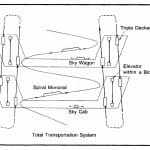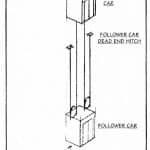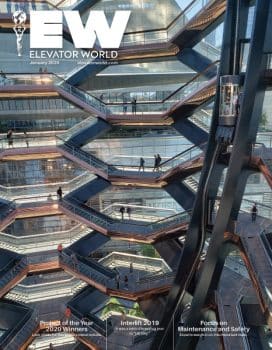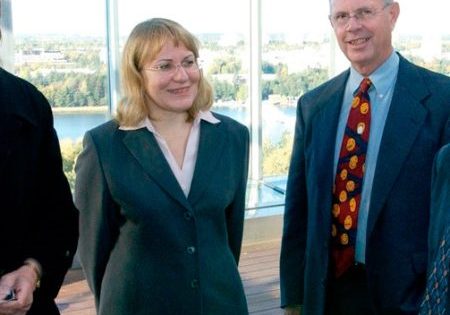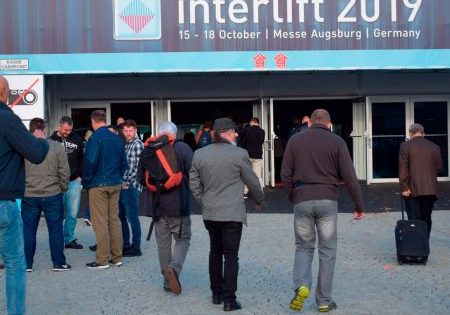2020 Vision: Hindsight and Foresight
Jan 1, 2020

A look back at an EW initiative shows many VT predictions have been realized in the last 25 years or are currently under development.
by Dr. Lee Gray, EW Correspondent
In January 1993, ELEVATOR WORLD founder William C. Sturgeon announced an ambitious new project. The announcement appeared in his monthly editorial column, “Speaking of Issues.” In this, his 480th editorial, he reminisced about the magazine’s origins and ofered refections on the previous 40 years. While he acknowledged the magazine’s editorial diversity had steadily increased over the years, Sturgeon observed that this expansion had primarily occurred in response to reader demand and industry changes. As the leading trade journal for the international vertical- transportation (VT) industry, responsiveness to current events was a reasonable editorial strategy.
However, perhaps with an eye toward the impending arrival of the new century, Sturgeon wondered if the magazine should be more than a mirror for the industry. It, perhaps, also had a responsibility to look to the future. To meet this new goal, he announced “2020 Vision,” a two-year initiative designed to challenge industry members to imagine what the elevator world would look like in the year 2020. Sturgeon suggested an intriguing array of possible topics for future articles (which he presented as questions): “Multiple cars in the same hoistway? A practical accelerating walkway? Foolproof doorway protection?
Economical spiraling escalators? A modern-day paternoster with detachable cabins? Economical magnetic propulsion?”[1]
Sturgeon’s January 1993 editorial was accompanied by two articles that launched 2020 Vision. The frst, “Structures and Elevators: The Past Is Prologue” by Keith Jenkins, provided an overview of innovations from the 1920s through the 1960s, as well as thoughts on future developments:
“Ultimately, we may have to move from the traditional elevator approach to the conveyor system concept. This means we will have a multiplicity of cabs in each hoistway. The cabs will be ejected from the system at a foor to allow loading and unloading of passengers and then injected into the system for moving up and down — a variation on the paternoster. . . an approach that may come to fruition is the extension of the sky lobby to large-scale projects. If, for example, the entire center core of a major city had buildings linked at sky lobbies, then a common VT system consisting of multi-deck and/or large-area cabs could be used to transport people between ground and sky lobby foors.”[2]
While Jenkins’ visions paralleled Sturgeon’s questions, he also included a new idea — groups of buildings could be linked and interconnected by skywalks, creating multilevel urban environments.
The second article was by James W. “Jim” Fortune. His article, “Elevatoring Frank Lloyd Wright’s Mile-High Building,” was essentially a reprint of a paper he had presented at Elevcon 4, held the previous year.[3] The article ofered an assessment of Wright’s proposed elevatoring solution. Recognizing the inadequate nature of its design, Fortune ofered an expert contemporary analysis of the elevator system required to serve a mile-high skyscraper. This assessment was used to generate a detailed list of the changes required to elevator future “mega- rise building projects (100-plus stories)”:
“The evolutionary changes can be accomplished by development of the following:
- An ACV3F 2,000-2,500 ft/m (10.16-12.7 mps) gearless hoist machine with a 10,000 lb./4,536 kg (double-deck) lifting capability
- Wind displacement-resistant hoistway equipment (trail cables, compensation cables and pit equipment)
- Car top and bottom windage shrouds and plenum cabs
- Voice recognition, call input sensors and call destination dispatching
- On-board cab people sensors and lobby crowd detectors “The revolutionary change possibilities:
- The development of high-speed (3,000-5,000 ft/m/15.24-25.4 mps?), linear induction lift drive motors, either built into the car or counterweight [with] power to be picked up from an electrifed rail or inductive coupling in the hoistway
- A re-pressurization airlock/cab system
- A high-speed, quiet, rack-and-pinion lift or counterweight drive system
- The ability to place multiple cars in dedicated express-lift shafts as trafc demands increase: this system requires the lifting pods to load and unload out of the hoistway and then move horizontally back into the shaft for VT
- A magnetic (repulsion) levitation (supercooled?) lift platform
- A gravity shield to control the application of gravity to the lift platform. (This will require a working model before a patent can be issued.)”[4]
Fortune’s decision to divide his future imaginings into evolutionary and revolutionary categories provided an interesting distinction between what he saw as the logical evolution of existing elevator technology and revolutionary change that would require the invention of new design approaches and technologies.
These “forward-looking” articles served as models for Sturgeon’s strategy in which industry members imagined what the future might hold. They were also the frst in a series of “paired” articles, which established the primary editorial approach to 2020 Vision. Over the next two years, Sturgeon published a series of paired articles that presented either complementary or difering views on various topics. The latter approach was evident in two articles that addressed the role of elevators in emergencies. Elmer F. Chapman, in “Elevator Design for the 21st Century: Design Criteria for Elevators When Used as the Primary Means of Evacuation During Fire Emergencies,” advocated for passenger use of elevators during emergencies:
“The time has come for the elevator industry to take the initiative and begin the work required to take the industry into the 21st century by designing elevators that can not only provide safe, reliable access to the upper stories of high-rise buildings, but also provide safe, reliable egress from these same buildings under fre emergency conditions…….. It is time for the eradication of all those signs found in all elevator lobbies that are derogatory to the elevator industry that read: “IN CASE OF FIRE, USE THE STAIRS.” These signs should be replaced with signs that read, “IN CASE OF FIRE, USE THE ELEVATORS.” Why tell your customers to use your competitor when they need you the most?[5]
Edward A. Donoghue, in “Elevators and Fire: A Rebuttal,” ofered a counterpoint to Chapman’s proposal. While he reported that, in fact, he agreed with many of Chapman’s ideas, he also believed that:
“Advising the public to use the elevator during a fre will prove to be fawed when panic strikes and the elevator is overloaded or power is lost. Elevators are extremely complex mechanical/electrical systems. They can be used by trained emergency personnel to assist in evacuating a building. In fact, they have been used during many fres. I know of no advocate for the elimination or reduction in the required number of exit stairs. If an elevator could truly be relied on to evacuate the building, why has there been no proposal to reduce the number of exit ways?”[6]
Donoghue also noted that the “ASME A17 Committee was aware of the problems encountered by the NYC Fire Department when operating elevators on [Firefghters’ Emergency Operation] Phase II.” [6]
In a pair of complementary articles that ran in a later issue, George Strakosch and Keith Jenkins endorsed the adoption of the recently developed rope brake:
“Recent designs have taken two paths: one, where the brake acts directly on the ropes which can be termed ‘direct’ and a second where the brake acts on the rope sheave. . . The intent of the newly prominent rope brake. . . is intended to both stop the elevator and prevent it from moving inadvertently in either the up or down direction — a feature [that is] not a current A17.1 code requirement.[7]
Strakosch believed rope brakes would allow the elimination of undercar safeties, a change that would have a signifcant domino efect:
“Without the weight of the car safety, the car frame can also be redesigned. Less weight on the car side of the ropes means less counterweight and reduced sheave shaft load on the drive machine. This translates into a lighter-duty machine and machine supports.”[7]
Jenkins’ endorsement was more cautious:
“The industry experience with rope brakes is, as yet, quite limited, and we might be well advised to delay any major changes in safety practices until more rope-brake empirical data is compiled. Having said that, now is the time to start thinking of future changes.”[8]z
In September 1993, Robert S. “Bob” Caporale (in his frst year at EW) contributed an article to 2020 Vision. Titled “Creating a Living Building Transportation System,” Caporale’s unique literary style was immediately evident in his introduction:
“Imagine for a moment that you are a modern Dr.
Frankenstein. Rather than a human being, however, you set out to create a building. You assemble the components. You mold the structural supporting skeleton. You carefully wrap the architectural skin around it. Time for the ‘building systems.’ In goes the electrical nervous system, then the HVAC respiratory system, the electronic brain and the sanitary evacuation system. You turn the switch on, and the building is ready. But, your creation is not a commercial success. Why? You didn’t include an adequate circulatory system — elevators, escalators and material handlers.”[9]
Caporale then proceeded to ofer readers a thorough account of the essential components of a modern elevator system. His article was planned as the frst of a pair of articles, with the second addressing material handling systems (dumbwaiters, automatic cart lifts, pneumatic tube systems, freight and service elevators, gravity and pneumatic chutes and track- and belt-conveyor systems). This broad overview was intended to prompt 2020 Vision responses from readers. Unfortunately, the second article, which was to be written by an industry member, never appeared.
In addition to pairs of articles, the initiative also featured standalone pieces and editorials. These included a second Caporale article published in September 1994 that imagined a multicar solution that utilized the follower-carriage concept as the basis for a follower car:
“With the lower car being roped 2:1 from the underside of the upper car, it would travel at one-half the upper car speed and always be one-half the distance from the upper car to the pit. The two cars would never be in contact, and conventional drive, control and safety systems could be utilized. Rope brakes interfaced with control equipment and rope-hitch sensors could be utilized at the machine room, on hoist ropes and hoistway dead-end hitch locations to further assure that leading and follower cars would be se- cured prior to overspeed or rope attachment problems.”[10]
Caporale’s idea was inspired by Keith Jenkins’ January 1993 article. Other standalone articles included Alan Casas’ article on a new emergency evacuation device, Galen Dutch’s article on programmable door-operating systems and an article by Rodger Howkins that outlined the changes needed in 21st century elevator design.[11-13] Howkins argued that the industry could not move forward until it engaged more innovative designers and abandoned its conservative attitudes regarding codes and regulations. He challenged every aspect of contemporary elevator practice and advocated for a radical rethinking of all basic assumptions and code requirements, as well as new attitudes toward safety gears, overspeed governors, guide rails, cab slings, cab design, door operators, controls, wiring and conduits and drives.
Many of the ideas presented in the articles produced under the auspices of Sturgeon’s 2020 Vision project have been realized in the last 25 years or are currently under development. However, it should also be noted that the relatively slow pace of change — and the number of ideas yet unrealized — may serve as evidence that Howkins’ criticism of the conservative nature of the VT industry still resonates today. If history tells us anything, it is that genuine change (of any kind) is hard and that radical or revolutionary change is even more difcult to achieve. Of course, that doesn’t mean we shouldn’t challenge ourselves and ask, particularly in the context of an increasingly complex global environment, “What should (or must) the elevator world look like in 2050?”
- Diagram of transportation system for Takenaka Corp.’s Sky City 1000[2]
- A summary of elevator analysis for Frank Lloyd Wright’s “Mile High Skyscraper”[4]
- Summary of the benefits of a rope-brake system[8]
- “Diagram of a living building transportation system”[9]
- A schematic diagram of a follower car system[10]
- “The evolution of fixtures and operating controls will parallel that of the cabs, resulting in use of smart cards,” the original caption read. (Graphics were provided by Fred English, copyright Ove Arup & Partners)”[13]
References
[1] William C. Sturgeon. “Speaking of Issues,” EW, January 1993.
[2] Keith Jenkins. “Structures and Elevators: The Past is Prologue,” EW, January 1993.
[3] James W. Fortune. “Elevatoring Frank Lloyd Wright’s Mile-High Building,” Elevator Technology 4: Proceedings of Elevcon ’92, Editor:
G.C. Barney. International Association of Elevator Engineers (1992).
[4] James Fortune. “Elevatoring Frank Lloyd Wright’s Mile-High Building,” EW, January 1993.
[5] Elmer F. Chapman. “Elevator Design for the 21st Century: Design Criteria for Elevators When Used as the Primary Means of Evacuation During Fire Emergencies,” EW, February 1993. Reprinted from the Journal of Applied Fire Science, Vol. 1, No. 4 (1992).
[6] Edward A. Donoghue. “Elevators and Fire: A Rebuttal,” EW, April 1993.
[7] George Strakosch. “Triggering of Major Changes? Will Rope Brakes or Sheave Brakes Stimulate a Substantial Change in Elevator Mechanical Design?” EW, March 1993.
[8] Keith Jenkins. “The Impact of Rope and Sheave Brakes on Elevator Systems,” EW, May 1993.
[9] Robert S. Caporale. “Creating a Living Building Transportation System.” EW, September 1993.
[10] Robert S. Caporale. “The Follower Car,” EW, September 1994.
[11] Alan Casas. “Another View: A New Fail-Safe Method for Emergency Elevator Evacuation,” EW, November 1993.
[12] Galen Dutch. “Gearless and Programmable Door Motion Control Minimizes Closing Force,” EW, February 1994.
[13] Roger Howkins. “Elevator Design Evolving Toward the Year 2020,” EW, March 1994.
Get more of Elevator World. Sign up for our free e-newsletter.
